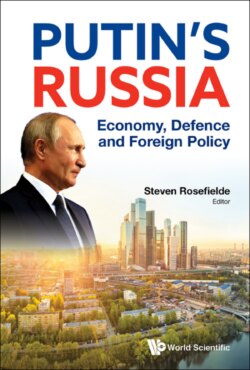Читать книгу Putin's Russia - Группа авторов - Страница 24
На сайте Литреса книга снята с продажи.
Are “normal” growth models relevant for Russia?
ОглавлениеIf we turn our attention to regular growth models that focus on factors that the literature has identified as fundamental drivers of growth, we may better understand what Russia needs to do to boost growth going forward. Becker and Olofsgård (2018) use a robust empirical growth model to understand differences in growth across 25 transition countries in the first 25 years since the dissolution of the Soviet Union. The model was originally specified and estimated by Levine and Renelt (1992) with a focus on identifying the robust determinants of growth among the long list of variables that have been used in empirical growth models. In the end, the authors show that initial GDP, population growth, human capital measured by secondary schooling and the ratio of investments to GDP are the most robust determinants of growth across a large number of countries and over time. The model was estimated without the transition countries that we study in Becker and Olofsgård (2018). We could therefore use the estimated model to see how well it predicted the growth experience of transition countries to investigate the question if (and when) transition countries can be thought of as “normal” countries from a growth perspective.3
Using the same methodology here but with a focus on Russia and the country groups that we used in Figure 1, we can generate predicted growth and compare this with the actual growth for the first decade of transition and then do the same with the 17 years that coincide with Putin being the President and Prime Minister of Russia. For the initial period, the model predicts that Russia would grow at 4.8% per annum, while in fact, income declined by 5% per year on average. Russia thus underperformed the expected growth by almost 10% points per annum. This is similar to the other FSU countries but far behind the EU10 group that “only” underperformed the model by around 5% points.
The picture changes dramatically when we look at the period 2000–2017. Both Russia and the peer groups have growth that comes very close to what the model predicts; the residuals are a few tenths of a percent up or down. In this sense, these countries are in this time period indeed “normal” countries.
The numbers in Table 1 also allow us to discuss the quantitative importance of the different fundamental growth factors in generating the predicted growth rates. The general impression is that human and physical capital as measured by secondary schooling and investments to GDP are of equal importance and of more significance numerically than the other variables. However, the second observation is that there is much less variation in the growth that is generated by human capital than by physical capital. If Russia had the secondary schooling of the average EU10 country, growth would only increase by 0.15% points while if the investment rate was on par with EU10 countries, growth would increase by 1.3% points. In other words, differences in investment to GDP ratios explain almost all of the difference in predicted growth between Russia and the EU10 countries. For the political leaders of Russia, this is an important message. The various proposals to modernise and diversify the economy can have a large impact on expected growth in Russia and with the right incentives to invest in sectors that are less subject to external volatility, this would also make Russia’s growth more robust.4 It is therefore important to understand how investments have evolved over time and how this can be explained. This is the focus in the following sections.
Table 1:Russia and peers — predicted and actual growth.
Source: Becker and Olofsgård (2018) based on Penn World Data 9.0 and additional calculations.
